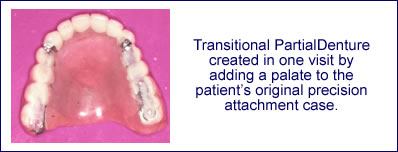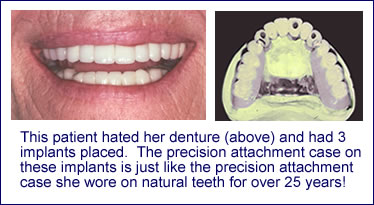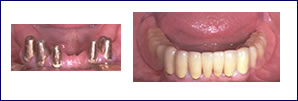 No one likes the thought of having to wear dentures, but having to wear dentures is not the worst thing that can happen to a person. There is no reason ever to walk around without teeth; and, in fact, no patient has ever left the office without teeth since 1948! If dentures are made properly, no one should be able to tell. Many times patients remark that not even their spouse knows they are wearing a denture!
No one likes the thought of having to wear dentures, but having to wear dentures is not the worst thing that can happen to a person. There is no reason ever to walk around without teeth; and, in fact, no patient has ever left the office without teeth since 1948! If dentures are made properly, no one should be able to tell. Many times patients remark that not even their spouse knows they are wearing a denture!
Dentures rest on tissue and function quite differently than natural teeth, fixed bridgework, or implant restorations which are anchored in place. As a result dentures cannot chew with the same pounds of pressure. They move and can dislodge during function. However, dentures do have the advantage of replacing missing periodontal structures—gingiva and bone—better than other restorations, including implants. Dentures can therefore provide better support for the musculature and lips when the bony ridges have resorbed. For this reason, denture wearers should wear their dentures all the time if possible; only removing them for hygiene.
Successful Fit of Dentures
The successful fit of dentures depends on the anatomy of the bony ridges, the quality of the oral tissues and the composition/abundance of saliva. It might not be possible to achieve “suction” and the finished denture might require the use of denture paste or powder in order to prevent loosening of the denture.
Because Dentures rest on tissue, sore spots can develop if the denture presses or irritates an area. Dentures may require several adjustments if sore spots develop during function.
About Immediate Dentures

An immediate denture is a denture that is inserted the day all the teeth in the arch are extracted. Most patients who receive an immediate denture almost never enjoy comfort with their new denture.

Patients with terminal dentition who require a denture should be eased into a denture whenever possible. A transitional partial denture that is gradually converted to a denture as teeth are lost greatly enhances comfort for the patient. Once a patient has a transitional partial denture, teeth can be added to it on the spot if necessary. There should never be any hurry to extract teeth unless they are causing pain or harm. Teeth can always be extracted at a later date; and it is far better to extract teeth when patients are really ready to have them extracted.

Patients who really hate dentures can have implants as long as they are candidates for implants. The placement of a as few as three implants is all that is necessary to convert a denture case into a precision attachment case (fixed bridgework in the front, removable bridgework in the back). Read more about precision attachment case on implants.
Esthetic Outcome of Dentures

Dentures offer the most latitude for choice of shape, size, color and position of the teeth with respect to the oral tissues. Choice of esthetic desires is limited only by anatomy and function. Because of the wide array of appearance possibilities that dentures offer, patients often have changing expectations/opinions of how they would like their dentures to look. We use the most esthetic porcelain teeth whenever possible and hand carve the palate and flanges so they are thin. We are committed to as many try-in visits as necessary to ensure that the patient is happy with the final result.
The Process of Making Dentures
The process of making dentures often involves working within the tolerances of materials (acrylic, composite and porcelain. A detailed impression of the ridges is taken initially, and this impression is key to the fit of the finished denture. The model created from this impression is the base on which the denture will be processed. After the correct relationship of the jaws has been determined, the teeth are set up in wax or a wax-like material to simulate the finished denture for try in. During this stage the teeth can be reset, altered or changed to the desires of the patient as long as basic requirements for function are met). Processing dentures can be tricky and error is often introduced in the laboratory during the processing procedure. Once the denture is processed it is much more difficult to move or change teeth because the teeth have to be stripped, reset and reprocessed.
Relining Dentures
Everyone’s body changes during the aging process and the mouth is no exception. When the mouth changes, a denture may no longer fit properly. In order to make it fit properly, a new inside surface (reline) will be necessary to make the denture conform to the remodeled tissues. Each patient is different. Some patients go many years without needing relines but others require frequent relines. Occasionally the musculature changes as the dentures function, causing the teeth to “disappear”. When this occurs, a new denture must be made to compensate for the changes. The worst restoration in dentistry is the lower denture, because the muscles of the tongue and cheek continually lift up the denture. Often there is not enough bony ridges for adequate retention of a lower denture. Anything that can enhance retention will vastly improve the quality of life for these patients. Even one tooth can vastly improve the stability of a lower denture. Patients who are missing lower teeth should most definitely consider implants to improve their quality of life.
OverDentures

If the patient has a few teeth or teeth that are not strong enough to support precision attachment cases or fixed bridgework, overdentures are an excellent treatment choice. The remaining teeth are covered with a thin layer of metal to seal them against decay, and the overdenture is made to fit over these teeth. The support of these teeth vastly improves the retention of the denture without the need for any type of locking mechanism that will apply destructive lateral forces to the teeth. As a result, teeth that support overdentures can last far longer than one would expect. However, if the teeth are lost in the future, the overdenture does not have to be remade. The missing teeth are simply filled in.
